With the release of OPC Router version 5.4, we are continuing our mission to make industrial data communication even more efficient, secure and transparent. This update brings a number of new features that significantly improve both the functionality and the user-friendliness of the OPC Router.

Versioning and project synchronization
OPC Router 5.4 introduces automatic versioning, which saves every project status as a snapshot. This allows you to access previous versions at any time, undo changes and restore incorrect configurations with just a few clicks. This ensures greater security and traceability, especially for complex projects with multiple developers or critical production systems that require rapid recovery.
In addition, the new project synchronization offers an automated synchronization function for redundant OPC Routers. It detects differences between two systems and enables automatic synchronization of project versions. As soon as a new configuration has been successfully tested, it can be transferred to the redundant OPC Router without any manual effort. This means that the system always remains consistent and the risk of version conflicts or outdated configurations is minimized.
These functions not only make administration and maintenance easier, but also reduce operational effort by eliminating sources of error and reducing the time required for manual updates.
How you benefit from it:
Enterprise functions: Automation for DevOps and CI/CD
Version 5.4 makes the OPC Router even more powerful for DevOps applications and continuous integration/deployment (CI/CD). You can now automate, modify and distribute projects and content directly using scripts and code. This saves time, reduces errors and ensures the smooth implementation of new configurations.
Changes to system configurations, interfaces or data flows can now be defined centrally and automatically rolled out to test and production systems. Companies with scalable infrastructures or several OPC Routers in different environments benefit in particular. The uniform configuration and administration ensures that all systems run synchronously and simplifies the management of complex installations.
- ConfigGit: Integrated support for Git versioning, allowing changes to be managed and documented efficiently.
- YAML support: Configurations can now also be defined via YAML files and applied automatically.
- Docker compatibility: The OPC Router can be operated in Docker containers, which enables flexible deployment.
How you benefit from it:
Extended data dashboards for improved monitoring
The OPC Router’s connection diagnostics have long provided transparent and reliable monitoring of data communication. With version 5.4, monitoring has now been expanded to include a new function specifically for plug-ins. Users can now track the status, utilization and performance of individual plug-ins in detail. This makes it possible to see how efficiently the individual plug-ins are working and whether there is potential for optimization.
- Plug-in status monitoring: status information can be called up for each plug-in.
- Live metrics on utilization and transfers: Shows how intensively plug-ins are being used.
- Optimized error analysis: Bottlenecks and problems can be detected immediately.
How you benefit from it:
More news in release 5.4
OPC UA Historical Access
The OPC Router was already able to retrieve real-time values from OPC UA servers and integrate them efficiently into industrial processes. With version 5.4, we are now expanding this functionality to include OPC UA Historical Access (HA). This means that historical data including timestamps can now also be retrieved from OPC servers that support HA. This enables even deeper analysis and long-term process optimization.
OPC Batch Read
Until now, data structures could be individually defined and configured in the OPC Router. The new Batch Read TO function makes this process even more efficient: It enables the use of placeholders in data structures such as line [no.] or machine [no.], so that recurring patterns are automatically recognized and adopted. This reduces manual effort and speeds up configuration considerably.
OPC Read Multiple
With OPC Read Multiple TO, complete directories and subfolders of an OPC server can now be read in one step. There are also filter options, e.g. to read only temperature values or to exclude certain data.
Security-Updates: Secure Redundancy & Secure Management
Communication between redundant OPC Routers was already reliable and efficient. With version 5.4, it is now additionally secured by end-to-end encryption with password protection. Furthermore, additional protection via HTTPS ensures even more security in data transmission and protects against unauthorized access.
Secure storage and management of passwords
In many IT environments, passwords often end up in version control, which poses a security risk. The new Secure Management function ensures that passwords are stored centrally, encrypted and managed securely.
